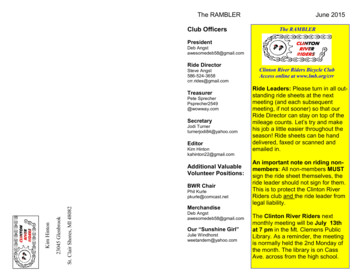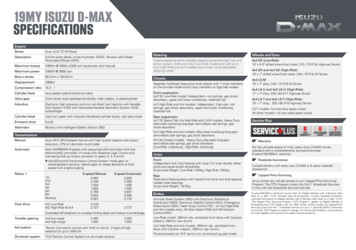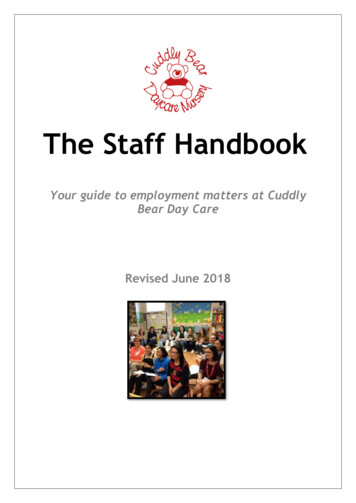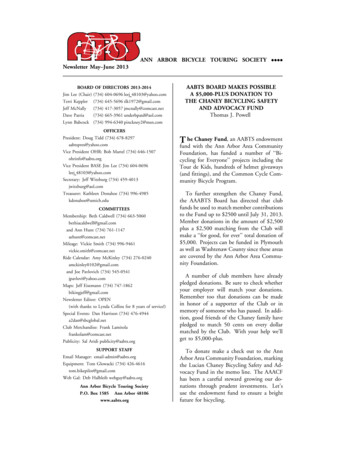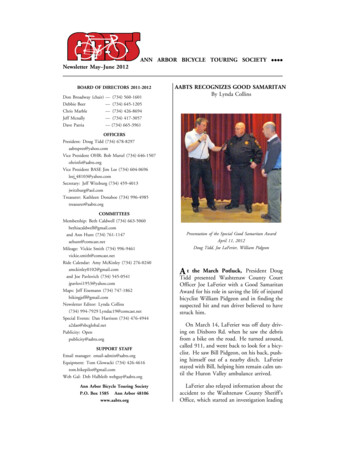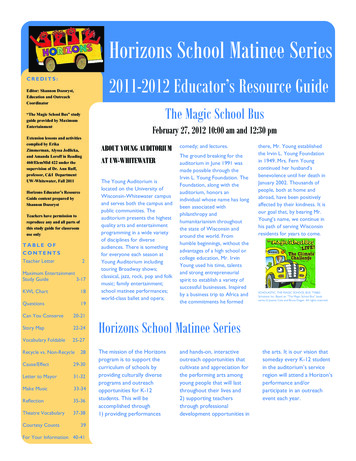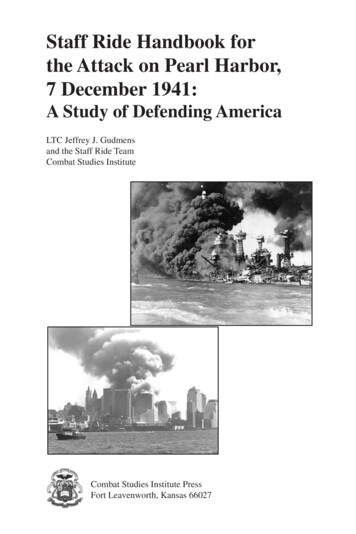
Transcription
Staff Ride Handbook forthe Attack on Pearl Harbor,7 December 1941:A Study of Defending AmericaLTC Jeffrey J. Gudmensand the Staff Ride TeamCombat Studies InstituteCombat Studies Institute PressFort Leavenworth, Kansas 66027
Cover photos: The photo of the attack on Pearl Harbor on 7 December 1941 isfrom the Naval Historical Center. The photo of the 11 September 2001 attack onthe World Trade Center is from the US Air Force Counterproliferation Center.
Staff Ride Handbook forthe Attack on Pearl Harbor,7 December 1941:A Study of Defending AmericaLTC Jeffrey J. Gudmensand the Staff Ride TeamCombat Studies InstituteCombat Studies Institute PressFort Leavenworth, Kansas 66027
Library of Congress Cataloging-in-Publication DataGudmens, Jeffrey J., 1960Staff ride handbook for the attack on Pearl Harbor, 7 December 1941 :a study of defending America / Jeffrey J. Gudmens and the Staff RideTeam, Combat Studies Institute.p. cm.Includes bibliographical references.1. Pearl Harbor (Hawaii), Attack on, 1941. 2. United States—ArmedForces—Organization. 3. Japan—Armed Forces—Organization. 4. PearlHarbor (Hawaii)—Tours. I. U.S. Army Combined Arms Center. CombatStudies Institute. Staff Ride Team. II. Title.D767.92.G84 2005940.54’266931—dc222005025669Reprinted June 2009
ForewordThe Pearl Harbor Staff Ride Handbook is the ninth study in the Combat Studies Institute’s (CSI’s) Staff Ride Handbook series. LTC JeffreyGudmens’ handbook on Pearl Harbor allows individuals and organizationsto study this battle not only in the context of the Japanese attack but, moreimportantly, in the context of issues that are relevant to the current globalwar on terror. In addition to analyzing the actual attack, Gudmens alsoenables users of this work to examine the problems associated with conducting joint planning and operations between the US Army, the Army AirForces, and the US Navy. He also provides insights into the problems of aHomeland Security environment in which intelligence operatives from aforeign nation (and potentially even recent immigrants from that foreignnation who are now US citizens) can operate with little hindrance in a freeand open democratic society. Additionally, this study provides an opportunity to look at how military commanders and planners prepared for theirwartime mission with inadequate resources and equipment. Each of theseissues, and others analyzed herein, is as relevant to us today as it was almost 65 years ago. Modern military professionals for whom this handbookwas written will find a great deal to ponder and analyze when studying theevents leading up to, and including, the attack on Pearl Harbor. They arelessons that we cannot afford to forget. CSI—The Past is Prologue!Timothy R. ReeseColonel, ArmorDirector, Combat Studies Institutei
ContentsPageForeword.iFigures. vIntroduction. 1I.The Militaries.5.US Organization.5.Japanese Organization.14.Ships. .18.Aircraft Carriers.18.Japanese Aircraft Carriers.19.American Aircraft Carriers.22.Battleships.23.Japanese Battleships.24.American s.30.Aircraft.32.Fighters.32.Japanese Fighter.32.American Fighters.33.Bombers.34.Japanese Bombers.35.American Bombers.36.Strategy. .38Operational. 42Tactics . 43Logistics. 45II. Pearl Harbor Campaign Overview. 47III. Suggested Route and Vignettes. 63Introduction. 63Stand 1. Japanese Espionage. 67Stand 2. Homeland Defense. 71Stand 3. American Intelligence. 75Stand 4. American Preparations. 80iii
PageStand 5.“Joint” Defenses. 88Stand 6.Preparednes and Early Warning. 94Stand 7.Japanese Air Superiority. 99Stand 8.Japanese Torpedo Attack. 104Stand 9.Japanese High-Level Attack. 108Stand 10.Japanese Second Wave. 113Stand 11.Aftermath. 119IV. Integration Phase for the Attack on Pearl Harbor. 123V. Support for a Staff Ride to Pearl Harbor. 129Appendix A. Order of Battle, Japanese Forces. 131Appendix B. Order of Battle, US Forces. 137Appendix C. Biographical Sketches. 143Appendix D. Medal of Honor Conferrals for the Attack onPearl Harbor. 153Bibliography.159.About the Author.163iv
FiguresPage1. US War Department Organization. 52. Hawaiian Department Organization.73. US Navy Department Organization. 84. US Chief of Naval Operations Organization. 95. Pacific Fleet Organization. 106. Task Force 1 Organization. 117. Task Force 2 Organization. 128. Task Force 3 Organization. 139. Japanese Government Organization. 1410. Combined Fleet Organization, 1941. 1611. Combined Fleet Organization, December 1941. 1712. HMS Argus. 1813. Akagi. 1914. Kaga. 2015. Soryu. 2016. Hiryu. 2017. Shokaku. 2118. Zuikaku. 2119. USS Lexington, CV-2. 2220. USS Saratoga, CV-3. 2221. USS Enterprise, CV-6. 2322. Hiei. 2423. Kirishima. 2424. USS Nevada, BB-36, Nevada Class. 2525. USS Oklahoma, BB-37, Nevada Class. 2526. USS Pennsylvania, BB-38, Pennsylvania Class. 2627. USS Arizona, BB-39, Pennsylvania Class. 2628. USS Tennessee, BB-43, Tennessee Class. 2629. USS California, BB-44, Tennessee Class. 27v
Page30. USS Maryland, BB-46, Colorado Class. 2731. USS West Virginia, BB-48, Colorado Class. 2732. Japan’s Furutaka. 2833. USS New Orleans, CA-32, New Orleans Class. 2834. Japan’s Amagiri. 2935. USS Helm, DD-388, Bagby Class. 2936. Japan’s I-68. 3037. Japan’s HA-19. 3138. USS Tautog, SS-199, Tambor Class. 3139. A6M2 Zero Fighter. 3240. P-40 Warhawk. 3341. P-36 Hawk. 3342. F4F3 Wildcat. 3443. B5N2 Kate Torpedo/High-Level Bomber. 3544. D3A Val Dive Bomber. 3545. B-17B Flying Fortress. 3646. B-18 Bolo. 3647. PBY-5 Catalina. 3748. SBD-2 Dauntless Dive Bomber. 3749. TBD-1 Devastator Torpedo/High-Level Bomber. 3850. Rainbow War Plans. 4051. “Crossing the T”. 4352. Main Force. 4453. Southern Operation, Dec-Jan 41. 5654. Fuchida Chart. 6155. Hawaiian Department Critical Sites. 7256. Battery Hawkins, Early 1920s. 8157. Organization of the Hawaiian Coast Artillery Command. 8358. Organization of the Hawaiian Department Mobile Forces. 8359. Organization of the Hawaiian Air Force. 84vi
Page60. Battery Hasbrouck, Early 1920s. 8861. Interceptor Command. 9162. USS Ward. 9663. Radar Track From Opana Radar Site. 9764. Japanese Planes Prepare for Takeoff, 7 December 1941. 10065. First-Wave Plan. 10166. Wheeler AAF Under Attack, 7 December. 10267. Pearl Harbor at 0757, 7 December 1941. 10468. Torpedo Attack on Pearl Harbor. 10569. Battleship Row as Seen From a Japanese High-Level Bomber. 10970. The USS Arizona Exploding After Being Hit by aHigh-Level Bomb. 10971. Battleship Row After the First Wave. 11072. Lieutenant Commander Samuel G. Fuqua. 11173. Second-Wave Plan. 11474. The USS Cassin Resting on the USS Downes After the Attack. 11575. The USS Shaw Explodes on 7 December. 11576. The USS Nevada on Fire and Trying to Head to Sea. 11677. Twenty-One Winches Right the USS Oklahoma. 121Stand MapsMap to Stands 1-3. 64Map to Stands 4-7. 65Map to Stands 8-10. 66vii
IntroductionSurprise, when it happens to a government, is likely tobe a complicated, diffuse, bureaucratic thing. It includesneglect of responsibility, but also responsibility so poorlydefined or so ambiguously delegated that action gets lost.It includes gaps in intelligence, but also intelligence that,like a string of pearls too precious to wear, is too sensitiveto give to those who need it. It includes the alarm that failsto work, but also the alarm that has gone off so often ithas been disconnected. It includes the unalert watchman,but also the one who knows he’ll be chewed out by hissuperior if he gets higher authority out of bed. It includesthe contingencies that occur to no one, but also those thateveryone assumes somebody else is taking care of. Itincludes straightforward procrastination, but also decisions protracted by internal disagreement. It includes, inaddition, the inability of individual human beings to riseto the occasion until they are sure it is the occasion whichis usually too late. Finally . . . surprise may include somemeasure of genuine novelty introduced by the enemy, andpossibly some sheer bad luck.*In his farsighted foreword to Roberta Wohlstetter’s excellent bookabout our failures before Pearl Harbor, Thomas C. Schelling describedhow and why the Japanese were able to successfully attack the US Pacific Fleet at Pearl Harbor in 1941. Prophetically, his words ring true indescribing the successful al-Qaeda attack against the United States on 11September 2001.On 7 December 1941 the United States suffered a devastating surpriseattack that thrust it into a worldwide war. Our enemy had extensivelyplanned the attack, conducted detailed reconnaissance of its target todetermine how to achieve the most destruction, and had innovativelyplanned the operation to overcome all obstacles. Two services that neededto work together were never ordered to do so, losing synergy that wassorely needed. The United States had indications that an attack was possible but had no single agency to gather all of the available informationfor an analysis that would suggest an attack. When the attack started, therewere indications that something large was happening, but the word wasnever spread, and our enemy’s attack was devastating.Sixty years later the United States was again thrust it into a worldwide1
war. On 11 September 2001 enemies of our nation conducted an overwhelming surprise attack against our homeland. Our enemy had againmeticulously planned the operation and conducted extensive reconnaissance of its targets before its destructive attacks. Many agencies in ourgovernment had indications of an attack, but again, there was no singleagency that analyzed all available intelligence to provide us a warning. Asword of the attack spread, people refused to accept that the impossible washappening, and again our enemy delivered an overwhelming attack.As our nation prosecutes the global war on terrorism, it is imperativethat we in the profession of arms study those events in which our homelandhas been successfully and directly attacked in the past. While attacking ourenemies around the world, we must first ensure that our homeland remainscompletely protected and safe. Not only should we study the tactics, techniques, and procedures of recent operations, but we also need to study history—events where we analyze the actions of both attacked and defenderso we are better prepared to handle similar situations that may arise in thefuture. We should study what mistakes we made and what things we didwell as well as the enemy’s successes and failures. We must do all of thisto increase our ability to prevent another attack on the United States.The United States is a nation in which it is easy to move about and see,even in a time of war, and our homeland is now a part of the battlespace,a target for our enemies. How do we prevent an enemy from observinga target when it is not overtly breaking the law? Our many intelligenceagencies provide outstanding intelligence, but how do we gather all ofthe information to synergistically determine our enemies’ intentions andget this information to the commanders who need it? Our job is to keepAmerica safe, and even when we are in the midst of fighting a war, it iscritical that we take the time to study the past so we do not make the samemistakes in the future.A staff ride has three distinct phases—a preliminary study, a fieldstudy, and integration (see The Staff Ride by Dr. William G. Robertson,published by the Center of Military History, for information on planningand conducting staff rides). The preliminary study phase prepares studentsto travel to the field and can be conducted through individual study, instructor-led lectures, discussion, or a combination of these. The field studyphase allows students to better understand historical events by studyingthem from actual locations. Finally, the integration phase allows the students to understand what happened, why it happened, and most important,what can be learned by studying the battle.2
The Staff Ride Handbook for the Attack on Pearl Harbor, 7 December1941 provides a systematic approach to analyzing how Japan planned forthe attack, the failures the United States made in preventing it, and theattack’s disastrous results. Throughout the book, pragmatic comparisonsof 7 December 1941 and 11 September 2001 are presented for analysis anddiscussion. Part I describes the organization of the Japanese and Americanforces, detailing their respective ships, aircraft, strategy, tactics, and logistics. Part II consists of a campaign overview that encompasses the road towar, planning, and intelligence, allowing students to understand how theforces met on the battlefield.Part III consists of a suggested route to use in conducting a staff rideof the attack on Pearl Harbor. For each stop, or “stand,” there is a set oftravel directions, an orientation, a description of the action or event thatoccurred there, and most important, a list of discussion points that a staffride leader can explore at each stand. Part IV provides information on conducting the integration phase of this staff ride and suggests areas to discussduring the integration phase. Part V provides administrative informationon conducting a staff ride at Pearl Harbor, including sources of assistanceand logistics considerations. Appendix A provides the Japanese order ofbattle at Pearl Harbor while Appendix B provides the order of battle ofAmerican forces in Hawaii during the battle. Appendix C gives brief biographical information on key participants. Appendix D is a list of Medal ofHonor recipients from the Pearl Harbor attack. An annotated bibliographyprovides sources for preliminary study.All dates used in this book are Hawaiian time (Japan is one day aheadof Hawaii). The attack on Pearl Harbor occurred on 7 December, whichwas 8 December in Japan.*Roberta Wohlstetter, Pearl Harbor: Warning and Decision (Stanford, CA:Stanford University Press, 1962), viii.3
I. The MilitariesUS OrganizationIn 1941 Franklin D. Roosevelt was the President of the United Statesand, as such, was Commander in Chief of the Army and Navy. He was assisted by the Secretary of War who oversaw the Army, including the ArmyAir Forces, and the Secretary of the Navy who oversaw the Navy and theMarine Corps.The Secretary of War in 1941 was Henry L. Stimson, who was 74years old (see figure 1). Stimson had served as the Secretary of War,1911-1913; Secretary of State, 1929-1933; and had begun his second termas Secretary of War in July 1940. The Army Chief of Staff was GeneralGeorge C. Marshall, 60 years old at the time of the attack, who had beenChief of Staff since 1939. Under Marshall were three deputy chiefs of staffand his staff (the G1, G2, G3, and G4 and the War Plans Division).US War Department Organization7 December 1941Secretary of WarHenry L. StimsonChief of StaffGEN George C.MarshallDCS/Gen Adminand Ground ForcesMG W. BrydenDCS/Armored Forcesand SupplyMG R.C. MooreDCS/AirMG H.H. ArnoldGeneral StaffG1, G2, G3,G4, WPDSpecial StaffChiefs andAdministrativeBureaus11.2.3.4.Chiefs blishments4Areas including JAG, finance, chaplain, QM, surgeon general, etc.Infantry, cavalry, field artillery, engineers, signal.Air Force Combat Command and other (air service, ferrying, training, etc.) commands.Hawaiian Department, US Army forces in the Far East, Atlantic bases, and CaribbeanDefense Command.Figure 1.5
Under the General Staff were six different component groupings. Thefirst group was the chiefs of the service and administrative bureaus (ordnance, quartermaster [QM], judge advocate general [JAG], finance, etc.)that kept the Army’s administration, supply, and services straight. Nextwere the chiefs of arms, the branches responsible for doctrine and training the soldiers assigned to the field forces. The continental United States(CONUS) was geographically divided into nine corps areas, the headquarters of which were responsible for training, administration of, and mobilizing Regular Army, Reserve, and National Guard units within their corpsareas. The Chief of Staff was also the commander of the field forces, the“warfighters” of the Army. Field forces were broken down into a CONUSsection and an overseas establishment. Air forces was the fifth componentgrouping, which was broken down into combat commands (the numberedair forces) and other commands (training, ferrying, etc.).The last component, which was really a subcomponent of the fieldforces, was overseas establishments. It was broken down into four subcomponents: the Hawaiian Department, US forces in the Far East, Atlanticbases, and the Caribbean Defense Command. In December 1941 the Armyhad 1,600,000 men on active duty. The US Army’s Hawaiian Department(see figure 2) had 42,857 men in December 1941 and was commanded byLieutenant General (LTG) Walter C. Short, who was 61. The HawaiianDepartment’s mission was to defend the Pearl Harbor Naval Base againstattack from the air, by expeditionary forces, enemy fleets, or sympathizers. To do this, Short had two understrength divisions, four antiaircraft(AA) regiments, four harbor defense regiments (two incomplete), a bombardment wing, a pursuit wing, aircraft warning units, and other supportunits.The Hawaiian Department was plagued by shortages of vital equipment. The air defense regiments had 86 of 98 authorized 3-inch AA guns,20 of 120 37-millimeter (mm) guns, and 113 of 246 .50-caliber machineguns. The Hawaiian Army Air Force had only 12 of the modern B-17s, 33B-18s (obsolete), and 12 A-20s. For fighters, it had 99 modern P-40s and53 obsolete P-36s and P-26s. The Hawaiian Department was also shortextended-range reconnaissance aircraft. The aircraft warning units hadonly received three of six authorized long-range fixed radar sets, but theNational Park Service held up installation on property that it controlled,so on 7 December none were operational. The Hawaiian Department additionally had six mobile radar sets, but due to a lack of qualified crews,they were only operational a few hours each day.The Secretary of the Navy in 1941 was Frank Knox, who was 67. At6
Hawaiian Department Organization7 December 1941CommanderLTG Walter C.Short24th DivisionBG D.S. Wilson19th InfantryCoast ArtilleryCommandMG H.T. Burgen25th DivisionMG M. Murray27th Infantry21st Infantry35th Infantry299th Infantry298th Infantry15th CoastArtillery Regt(Harbor Def)16th CoastArtillery Regt(Harbor Def)41th CoastArtillery Regt(Railway)55th CoastArtillery Regt(155)64th CoastArtillery Regt(Semimobile AA)97th CoastArtillery Regt(Semimobile AA)98th CoastArtillery Regt(Semimobile AA)Hawaiian ArmyAir ForceMG F.L. Martin18thBombardmentWing14thPursuit WingHickamFieldWheelerFieldBellowsField251st CoastArtillery Regt(Mobile AA)Figure 2.the outbreak of the Spanish-American War, Knox enlisted and joined Theodore Roosevelt’s “Rough Riders.” Knox was impressed with Rooseveltand became one of his main advisers. Knox had been a newspaperman.Starting as a reporter, he worked his way up to general manager of all ofWilliam Randolph Hearst’s newspapers and finally to become the publisher of the Chicago Tribune. Despite being a Republican, Franklin Roosevelt7
appointed him Secretary of the Navy. Knox’s Chief of Naval Operations(CNO) was Admiral Harold R. Stark, who was 61 and had spent his careeras a battleship and cruiser man.The Navy Department’s organization (see figure 3) was similar to thatof the War Department, but there were some differences. Like the WarDepartment, there were many administrative and logistics bureaus (ordnance, supplies and accounts, and ships), but unlike the War Department,the Navy bureaus worked directly for the Secretary of the Navy. The CNOcoordinated with these agencies, but he had no direct command authority.The US Marine Corps (USMC) also directly reported to the Secretary ofthe Navy.US Navy Department Organization7 December 1941Secretary of the NavyHenry L. StimsonChief of Naval OperationsADM Harold R. StarkOperating Forces,Marine and NavalDistrictsHeadquarters,Marine CorpsBureauof NavigationOrdnanceAeronauticsShipsYards and DocksSupplies and AccountsMedicine and SurgeryFigure 3.8
The CNO was the Navy’s warfighter (see figure 4) and was chargedwith “the operations of the fleet, and with preparation and readiness ofplans for its use in war. . . .” The CNO’s main warfighting subordinateswere the commanders of the Atlantic Fleet, Pacific Fleet, and Asiatic Fleet.The senior of these three fleet commanders was also designated as theCommander, US Fleet, whose mission was to command if two or morefleets were combined. The Naval Coastal Frontier Forces were responsiblefor defending ports and other coastal areas deemed important to the Navy.The special task forces were groupings of ships task organized and assembled for particular missions, and once the mission was complete they weredisbanded. Special duty ships were ships that performed specific missions,such as surveys, that the Navy only had a few of. The Navy TransportationUS Chief of Naval Operations Organization7 December 1941Chief of Naval OperationsADM Harold R. StarkUSFleet(Kimmel)Atlantic FleetADM Ernest J.KingCoastalFrontierForcesPacific FleetADM Husband E.KimmelSpecialTaskForcesSpecialDutyShipsAsiatic FleetADM Thomas e 4.9
Pacific Fleet Organization7 December 1941CINCPACADM Husband E.KimmelTask Force 1VADM W.PyeCdr, Battle ForceTask Force 2VADM W.HalseyTask Force 3VADM W.BrownCdr, AircraftBattle ForceCdr, Scouting ForceTask Force 4RADM C.BlochTask Force 7RADM T.WithersTask Force 9RADM P.BellingerTask Force 15RADM W.Calhoun14th NavalDistrictCdr, SubmarinesScouting Force30 submarines4 sub tendersCdr, PatrolWing 278 PBYs9 SeaplanetendersCdr, Base Force4 cruisersFigure 5.Service was responsible for all logistics shipping while the naval districtcraft were specific craft assigned
Pearl Harbor Staff Ride Handbook is the ninth study in the Com - bat Studies Institute’s (CSI’s) Staff Ride Handbook series. LTC Jeffrey Gudmens’ handbook on Pearl Harbor allows individuals and organizations to study this battle





